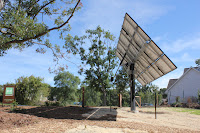There are TONS of restaurants in Minneapolis which offer local foods. However, the definition of 'local' is slightly different at each, and it varies quite a bit how local the restaurants go. For example, many 'local foods' restaurants simply give preference to local foods while they are in season. Some offer local foods in almost all dishes, but the entire dish isn't local (all ingredients). I have yet to find a restaurant that is ENTIRELY LOCAL all the time, or one that uses sunflower oil instead of olive oil. This would require the restaurants to freeze, dry, can and preserve foods in a way which is often less desirable their patrons. People would rather eat fresh especially when eating out, and I would assume that restaurants would shy away from preserving foods simply to give themselves a 'year-round-local' title. Here is a list I have so far of restaurants in Minneapolis that offer local foods (at least part of the year, in SOME of their dishes)
_Local D'Lish (localdlish.com)
_Crema Cafe (cremacafeminneapolis.com)
_Red Stage Supperclub (redstagsupperclub.com)
_Common Roots Cafe (commonrootscafe.com)_Birchwood Cafe (birchwoodcafe.com)
_Galactic Pizza (http://www.galacticpizza.com/)
_Spoonriver (spoonriver.com)
_Alma (restaurantalma.com)
_Brasa Premium Rotisserie (brasa.us)
_Lucia's Restaurant (lucias.com)
_Craftsman Restaurant (www.craftsmanrestaurant.com)
_Heartland (www.heartlandrestaurant.com)
This list is by no means exhaustive, and I would appreciate any other suggestions of places I should check out!
In order to figure out which restaurants offer the most 'local' food for the longest period of the year I am trying to visit many of the Minneapolis restaurants claiming to be 'local'. Today, we ended up at Galactic Pizza, the self-proclaimed "Planet Saving Pizza" of Uptown, Minneapolis. This is their vision:
"At Galactic Pizza we have a positive vision of the future on our planet. We see a world that lacks the greed and self centeredness that has led use into the chaotic state that we see today. We see a world full of cooperation, sustainability, and harmony with our surroundings.
In order to help achieve this positive vision, we strive to be the perfect example of what is called a values led company. This means that we realize that we have a responsibility to the people and community that make our existence possible. In order to fulfill this responsibility, we seek to maximize our impact by integrating as many socially beneficial actions into our day to day operations as possible. By incorporating a concern for the community--local, national, and global--our restaurant can make positive impact on the world in which it operates."
This place is 3 blocks away from me, and is pizza, so that's good. They have all kinds of sustainability-minded initiatives going;
_deliveries in 100% electric vehicles,
_all power purchased to run the restaurant in wind energy,
_many organic options,
_use packaging that is either made from recycled materials or is 100% biodegradable (compostable), you can return your pizza boxes to them to be composted!,
_when in season purchase all of the produce from local Minnesota farms, composting food waste
So that is great, in general, without oil these guys would be pretty well off since the entire infrastructure of their business is more or less oil free; renewable energy, electric cars, composting waste and reusable/compostable packaging, local foods.
We had the Paul Bunyan Pizza, according to the menu: "This is a very special pizza. The first of its kind. All of the toppings have been selected based on the fact that they are native to the Minnesota ecosystem, giving it a unique flavor that is truly Minnesotan. It starts with our homemade tomato sauce, topped with mozzarella cheese, morel mushrooms, wild rice, and free range bison sausage."
They also offer a few other all-local pizza's, CSA pizza which changes weekly as they get different produce in their CSA box...
They also dress up like super heros. yes.
TEN REASONS TO EAT LOCAL FOOD (http://fogcity.blogs.com/jen/2005/08/10_reasons_to_e.html)










